When you buy through our links, we may earn an affiliate commission.
With so many electric guitars available today, knowing which brand or model to go for is difficult. Once you choose a manufacturer, you still have to choose between the models they produce.
The Telecaster is an iconic instrument, combining exceptional tone with effortless playability. With that in mind, we’ve selected the best versions of Telecasters to suit all budgets and playing styles.
Our #1 recommendation is the stunning Fender American Ultra Telecaster, which offers a classic design with modern enhancements.
Choosing the best Telecaster will allow you to improve your skills, tone, and, most importantly, your enjoyment of playing guitar. Let’s check out our top picks!
Quick Summary of the Best Telecasters
- Fender American Ultra Telecaster (Best Overall)
- Fender Player Telecaster (Best Clean Tone)
- Fender Richie Kotzen Telecaster (Best Tele for Lead Guitar)
- Fender Special Edition Custom Telecaster FMT HH (Best Midrange Telecaster)
- Squier Classic Vibe '50s Telecaster (Best Budget Telecaster)
- Fender American Professional II Telecaster (Most Playable Tele)
Best Telecasters
1. Best Overall – Fender American Ultra Telecaster
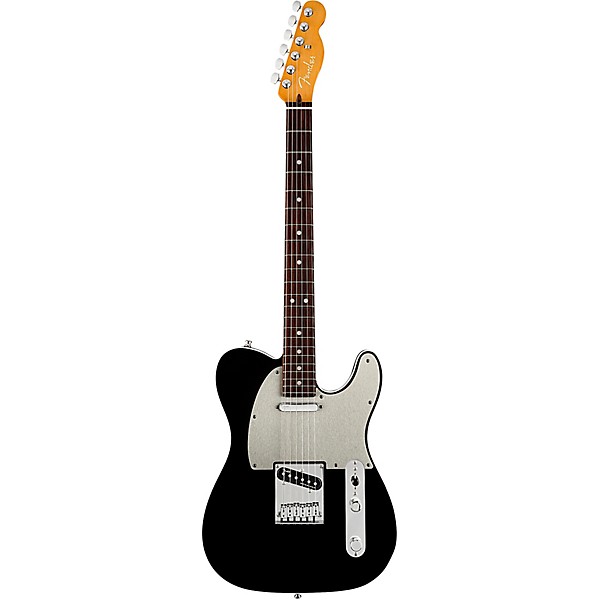
SPECS
- Body Material: Alder
- Neck Material: Maple
- Pickups: 2 x Ultra Noiseless Vintage Tele Single-coil
- Neck Profile: Modern D
The American Ultra Telecaster is our choice for the best overall, as it delivers all of the qualities that have made the Tele so popular over the years.
At first glance, this guitar looks like a vintage Tele from half a century ago. However, once you plug it into your amplifier, it becomes apparent that Fender has modernized the classic design.
Even if you play this Fender Telecaster for several hours at a time, you won’t experience the usual strains on your body thanks to the innovative contours added to the heel, back, and top. Navigating the rosewood fingerboard is effortless, thanks to the rolled-edge design.
Then there’s the aspect of this guitar that impressed us the most - its tone. The classic Tele “twang” is present mainly in the upper mids thanks to the single-coil pickups, but the full-bodied low end is equally impressive.
The only downside to this guitar is that the tapered neck heel, which is not found on most Telecasters, took a while to get used to. However, it does make it easier to quickly slide up to the higher frets once you become accustomed to the design.
2. Best Clean Tone – Fender Player Telecaster
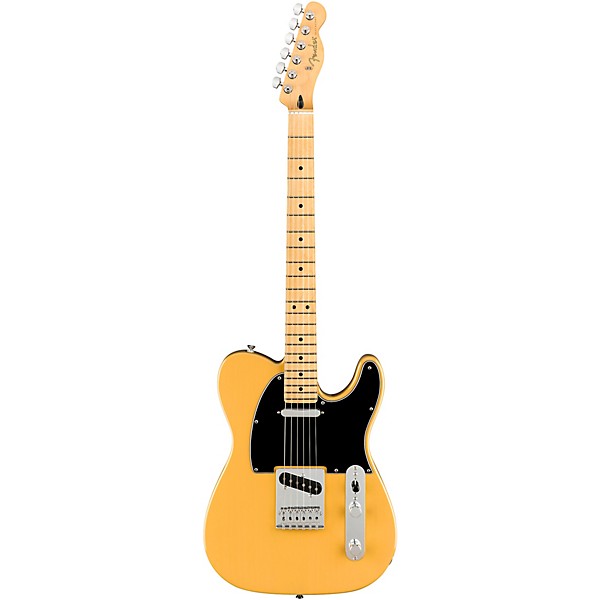
SPECS
- Body Material: Alder
- Neck Material: Maple
- Pickups: 2 x Player Series Alnico V Tele Single-coil
- Neck Profile: Modern C
The Fender Player Telecaster is an excellent option for guitarists who want to experience the unrivaled comfort and tone of a Tele at a very reasonable price. This guitar delivers a bright and versatile, inviting, clean tone thanks to the double single-coil pickup configuration.
I like that Fender has returned to the Telecaster’s roots when designing this model. Models from the ‘60s and ‘70s inspire the design of the alder body, but the 22-fret neck is a welcome change that makes it easier to play rhythm guitar.
Even some of the best Telecasters lack sustain when ringing out a chord or a note, but this is not the case with the Player Tele. If you like to use an overdrive or distortion pedal, you’ll be able to enjoy long-lasting sustain and control over your dynamics.
Even if you play with a lot of speed and energy, the strings on this Fender Player Telecaster are likely to stay in tune for much longer than your average solid-body guitar. Combined with the string-through bridge, sealed tuners ensure excellent tuning stability and intonation.
3. Best Tele for Lead Guitar – Fender Richie Kotzen Telecaster
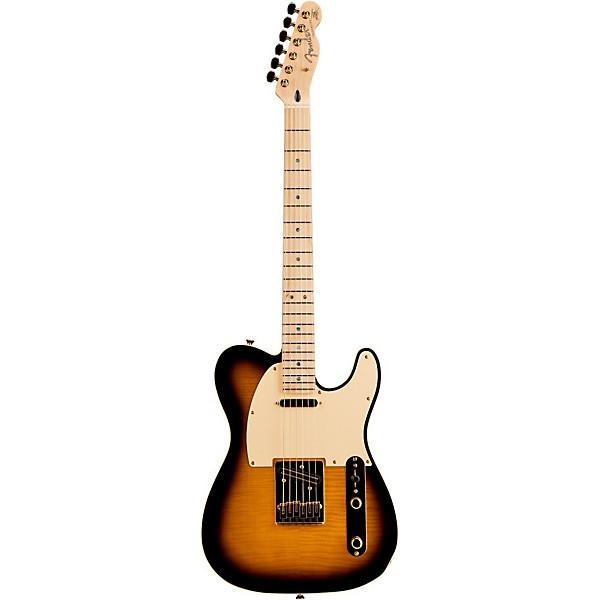
SPECS
- Body Material: Ash
- Neck Material: Maple
- Pickups: 1 x DiMarzio Twang King Single-coil 1 x DiMarzio Chopper T Humbucker
- Neck Profile: Large C
This collaboration between Fender and the world-renowned rock guitarist Richie Kotzen has quickly become one of the most popular modern Fender Telecasters. With its combination of a fast-playing neck, and red-hot DiMarzio pickups, it’s a unique version of the classic solid-body axe.
One of the things that impressed me most about this guitar is the attention to detail that has gone into its design. As I examined the finer details, I began to realize that every single component has been chosen and positioned for a specific purpose.
The lead guitar tones that this guitar produces are breathtaking. I found it to be equally well suited to solid-state and tube amplifiers, particularly when the pickup selector is set to the bridge position, where the DiMarzio Chopper T resides.
The punchy tone of this pickup is complemented by the Twang King in the neck position, which offers a more traditional Tele tone and is a great choice for jangly chord patterns or bluesy licks.
Other aspects of the design, like the 12” radius fingerboard and large C-shaped maple neck, give this Telecaster a familiar feel, but it is perhaps not the best choice for jazz or pop guitarists.
4. Best Midrange Telecaster – Fender Special Edition Custom Telecaster FMT HH
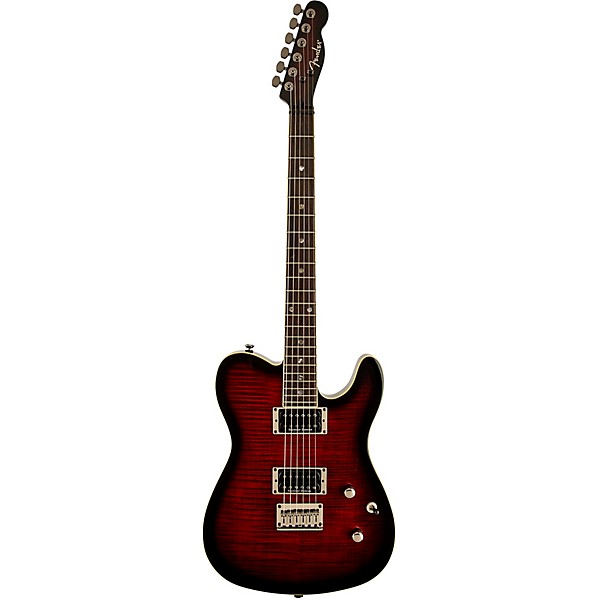
SPECS
- Body Material: Mahogany
- Neck Material: Mahogany
- Pickups: 1 x Seymour Duncan '59 SH-1N RP Humbucker 1 x Seymour Duncan SHPGP-1B Pearly Gates Plus Humbucker
- Neck Profile: Modern C
This special edition guitar is no ordinary Telecaster. When designing it, Fender set out to create the perfect Tele for rock and heavier styles, and the results are awesome.
One of the things that stood out to me initially about this guitar was how compatible it is with a tube amp. The high ocean Seymour Duncan wide-range humbuckers are perfect for pushing your amp’s tubes into overdrive while retaining the warm tone that the Tele is renowned for.
I also love the quality of the tonewoods that Fender has used when assembling the FMT HH. A mahogany body offers ample sustain, allowing you to hold those bends in the higher registers for longer when shredding out a solo.
Having a bridge and neck humbucker on a Telecaster is quite rare, but if you like to play heavy and hard, it’s the perfect addition to this guitar.
5. Best Budget Telecaster – Squier Classic Vibe '50s Telecaster
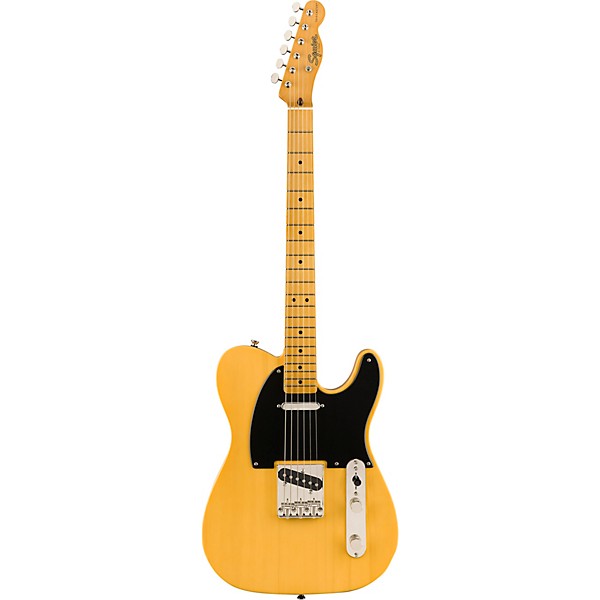
SPECS
- Body Material: Pine
- Neck Material: Maple
- Pickups: 2 x Fender Designed Alnico Single-coil
- Neck Profile: C
Squier is Fender’s more affordable sibling company, but in recent years the gap in quality between these budget models and the high-end Fender models has closed. The Classic Vibe ‘50s Tele is a prime example of this.
Aesthetically, it’s difficult to tell the Squire Tele apart from its Fender-made counterparts. This axe is inspired by Leo Fender’s original models from over 70 years ago, with vintage features like the black pickguard and the three-saddle string through body bridge all present.
As soon as I plugged this guitar into my amp, it produced the classic Telecaster sound. There are no overcomplications to the tone; it's just consistent, warm, and twangy, which is everything you could need from a Telecaster.
While you don’t get the level of quality and attention to detail that you would on a high-end Fender Telecaster, there’s no denying that this Squier model is a brilliant option for beginners or those on a budget.
6. Most Playable Tele – Fender American Professional II Telecaster

SPECS
- Body Material: Roasted Pine
- Neck Material: Maple
- Pickups: 2 x V-Mod II Tele Single-coil
- Neck Profile: Deep C
If comfort is one of your top priorities when playing guitar, then the Fender American Professional II Telecaster is definitely worth considering.
The thing that sets this guitar apart from most other Telecaster models is the way it feels. The luxurious playability results from a combination of components and materials, making it a joy to play.
Fender upgraded the neck from the previous American models, and I could feel the difference as soon as I played a riff. It’s effortless to glide up and down the frets, thanks largely to the “Super Natural” satin finish that Fender has coated the C-shaped maple neck in.
If you like to utilize the highest notes when playing, you can easily slide up to the upper registers without being hampered. The contoured heel gives you plenty of space to work with when you’re up at the treble end of the guitar.
Best Telecasters Buyer's Guide
The Fender Telecaster has consistently ranked amongst the most popular electric guitars in the world since Leo Fender first introduced it in the 1950s.
This popularity has led to Fender creating various editions of its iconic solid-body axe, from the Telecaster Deluxe to the Telecaster Thinline or the more affordable range of Squire Telecasters. It’s, therefore, vital that you know what to look for when navigating all the options.
Whether it’s choosing between maple or rosewood frets, opting for a modern instrument, or deciding on a vintage 70s Telecaster model, there are many things to consider.
In our buyer’s guide, we’ll cover every aspect of this iconic solid-body guitar so that you can make the right decision. We’ll take you through the individual components and explain how they impact the tone and playability of a Telecaster.
Things to Look for When Buying a Telecaster
1. Playability: The Telecaster is a highly playable guitar, thanks to its lightweight body and comfortable neck design. However, certain models are more playable than others.
The neck profile, action, and physical dimensions of the Tele all contribute to its playability. You need to consider whether you prefer a thicker or thinner neck, a heavier or lighter body, and so on.
2. Tone: You’ve probably heard the term “Tele twang” before, but there’s more to the sound of this electric guitar than that one aspect.
Telecasters with two single-coil pickups produce a snappy, bright tone, while models with humbuckers will add some thickness and warmth to the tone.
3. Quality and Craftmanship: The quality of the materials used to construct a Telecaster impacts everything from the dynamics to the instrument's longevity.
Components, such as the Telecaster bridge, locking tuners, and other hardware, all contribute to the overall quality of the guitar.
4. Price and Value: As you can see from the diverse range of Telecasters featured in this guide, the cost varies significantly.
High-end models, which come with the finest components and materials, will likely provide you with better results, but you don’t necessarily need to spend a small fortune to get your hands on Squier Telecasters.
The Telecaster Tone
The Fender Telecaster is famous for its appearance and history, but its tone sets it apart from most solid-body electric guitars. Popularly described as the Tele “twang,” the tone of this guitar has some distinguishable and unique qualities.
The twang produced by the Telecaster is characterized by a bright, percussive, and sharp tone that has made it a hugely popular instrument for country guitarists over the years. Thanks to its unquestionable versatility, it’s also very well suited to genres such as blues, rock, and jazz.
Lead guitarists often prefer the Telecaster, but it can also be used for rhythm guitar with the right combination of amplifier and effects pedals.
The distinctive Telecaster tone is a result of several key factors, which we’ll look at in detail in this buyer’s guide. Aspects like the onboard pickups, the bridge design, and the body design all contribute to the tone of a Tele.
Pickup Configurations
Traditionally, Fender Telecasters come with two single coils in the bridge pickup and neck position. The bridge pickup is commonly installed on a metal plate, which contributes to the typically bright, sharp, classic Tele tones that are well-suited to country and rock lead guitar.
The neck pickup produces a smoother, warmer tone, ideal for blues and jazz guitarists. Between these two pickups, plenty of variation can be achieved. The single coils deliver a classic Tele sound that can be heard on popular recordings in almost all genres.
In some cases, Fender chooses to install wide-range humbuckers made by the likes of Seymour Duncan in the bridge position. The Fender Special Edition Custom Telecaster FMT is an example of this, offering more variation between the two pickups.
Although, unlike the Stratocaster, there’s no middle pickup installed on a conventional Telecaster, you can make significant alterations to the sound by tweaking the master tone knobs. Likewise, the master volume controls offer an easy way to adjust the guitar's dynamics.
Telecaster pickups are most commonly made by Fender, but some custom models like the Richie Kotzen Telecaster have Specific pickups made by highly respected brands, in this case, DiMarzio.
Woods and Materials
As you can see from the specifications of the best Telecasters we’ve covered in this guide, different materials are used for the various components.
Our top pick. The Fender American Ultra Telecaster has an alder body and maple neck. This is widely considered the best combination for a Tele because the alder produces a balanced tone, while the maple neck increases clarity and sustain.
Maple is also a common choice for Telecaster fingerboards, with rosewood being a close second. Maple is harder and denser, while rosewood is softer, which results in a slightly warmer and more muted tone.
When it comes to the body of a Telecaster, ash and pine are two common alternatives to alder. Ash, or swamp ash, to be specific, is chosen for its lightness and the fact that it increases the resonance of a guitar.
Pine was used for the body of Leo Fender’s Broadcaster, which was the original Telecaster and has experienced a resurgence in popularity in recent years due to its unique, vintage tone.
Neck Profiles
The neck profile indicates the shape and size of a Telecaster’s neck. Fender uses slightly different neck shapes to make certain Tele models better suited to particular playing styles.
The most common neck profile used for Telecasters is the “C” shape, which is generally considered comfortable by most guitarists. Variations, such as the “Deep C,” “Modern C,” and “Large C” necks, offer slightly different shapes to cater to different preferences.
The “Modern D” neck profile, which is used by Fender on the Fender American Ultra Tele, is a little flatter than the “C” profile.
It has slightly squared shoulders, which makes it well suited to shredding and playing at speed due to the increased pressure that a player can apply with their thumb on the rear of the neck.
Hardware and Components
If you analyze the best Telecasters, you’ll find a wide range of hardware and components installed on the instruments. Some components are purely for aesthetic purposes, while others have a noticeable effect on the sound, dynamics, or playability of the guitar.
It’s common for Fender to install vintage-style tuners on Telecasters, as can be seen on the Special Edition Telecaster Custom we recommended. Other noticeable components include brass barrel saddles or bent steel saddles for ultimate tuning and intonation.
The Fender logo can often be found on the Telecaster models, giving them an authentic look. You might also find that the traditional “ashtray” Tele bridge is included, or on modern-style Telecasters, there are likely to be six individual saddles.
Frequently Asked Questions (FAQs)
What musical genres are Telecasters most suitable for?
The best Telecasters are renowned for being highly versatile, and they have been used across a vast array of musical genres since they were first introduced. The genre they’re perhaps most synonymous with is country, as the legendary “twang” suits the tone of this style perfectly.
Additionally, guitarists in the genres of rock, blues, indie, and jazz can all benefit from the tone and playability of a Telecaster. The guitar can also be used with a variety of amplifiers and pedals to tailor its sound to suit your style.
Even metal guitarists use the Telecaster sometimes, which is further evidence of its wide spectrum of tones.
How does the wood used in the construction of a Telecaster affect its tone?
Other than the pickups that are installed in a Telecaster, the aspect that most impacts the tone of the guitar is the combination of woods that are used to construct it.
The wood types are so important because each different variety adds certain qualities to the overall sound produced by the Tele. For example, a Telecaster with an ash body will sound brighter than an alder body, which offers increased warmth and resonance.
Maple necks and fingerboards are also renowned for their brightness and clarity, while rosewood will get you a softer tone.
It’s important to note that it’s not just the type of wood that impacts the tone of a Telecaster but also the quality of the wood.
How does the Telecaster compare to a Stratocaster?
The Telecaster and Stratocaster are Fender’s two most popular and iconic electric guitars. Although they share some similarities, such as being solid body guitars, there are several key differences between them.
The Telecaster has one bridge pickup and one neck pickup, most commonly a pair of single coils. On the other hand, the Strat has three pickups, with an additional one placed in the middle pickup. These three pickups are often all single coils or, in some cases, a humbucker installed in the middle position.
Other than the different pickup configurations, there is also a noticeable difference in the physical design of these two Fender guitars. The strat has a more contoured body, while the Tele’s body is flatter.
Tonally, the Stratocaster produces a clear, bell-like tone, compared to the more twangy, bright tone of the Telecaster. On the whole, both are considered to be very versatile electric guitars.
Is the Fender Telecaster a good guitar for beginners?
One of the great things about the Telecaster is that it is equally well suited to beginners as it is to experienced guitarists. This is because it combines a highly comfortable design with the versatility required to play in many different styles.
A wide range of Telecaster models exists, from budget Squire Teles to the more expensive Fender-made guitars. This variety makes them accessible for all musicians regardless of budget or experience level.
The best Telecasters should ultimately be easy to play for all guitarists, as this is a sign of a great guitar.
Closing Thoughts
Now that you’ve read our comprehensive guide on the best Telecasters, you can choose the specific model that best suits your needs.
Our top pick is the fantastic Fender American Ultra Telecaster, which is made from the highest quality materials and delivers the classic Tele tone with a convenient modern design. Alternatively, the Squire Classic Vibe '50s Telecaster is an excellent budget option.
Whichever of the best Telecasters you choose from our recommendations, you’ll experience the iconic tone and legendary feel this solid-body guitar has offered since the 1950s.
